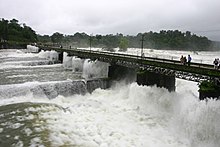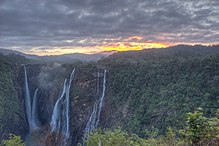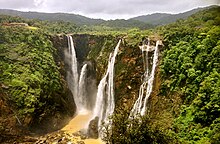Jog Falls
| Jog falls ಜೋಗ | |
|---|---|
 Jog Falls | |
 | |
| Location | Sagara, Shivamogga |
| Coordinates | 14°13′44″N 74°48′43″E / 14.22889°N 74.81194°E / 14.22889; 74.81194Coordinates: 14°13′44″N 74°48′43″E / 14.22889°N 74.81194°E / 14.22889; 74.81194 |
| Type | Cataract, segmented |
| Elevation | 488 metres (1600 ft MSL) |
| Total height | 253 meters (829 feet) |
| Number of drops | 1 |
| Longest drop | 254 meters (829 feet) |
| Average width | 472 meters (1550 feet) |
| Watercourse | Sharavati River |
| Average flow rate | 153 m³/s or 5,387 cu ft/s |
Jog Falls, Gerosoppa Falls or Joga Falls, located in sagara taluk, is one of the highest plunge waterfalls in India[1] .[2] It is a segmented waterfall which, depending on rain and season, becomes a plunge waterfall. The falls are a major tourist attraction and is ranked 13th in the world by the waterfall database. They are also known as the Gersoppa Falls or Jogada Gundi.[3]
Contents
1 Description
2 Etymology
3 Significance
4 Change in flow
5 Power
6 Transport connectivity
7 Gallery
8 See also
9 References
10 External links
Description
Jog Falls is created by the Sharavathi River dropping 253 m (830 ft), making it the second-highest plunge waterfall in India after the Nohkalikai Falls with a drop of 335 m (1100 ft) in Meghalaya.[4]
Sharavathi, a river which rises at Ambutirtha, next to Nonabur, in the Thirthahalli taluk and takes the northwesterly course by Fatte petta, receives the Haridravati on the right below Pattaguppe and the Yenne Hole on the left above Barangi. On arriving at the frontier it bends to the west, precipitates itself down the Falls of Gersoppa, and passes that village (properly Geru-Sappe), which is some 29 kilometres (18 mi) distant, discharging into the sea at Honnavar in Uttara Kannada.
The Sharavati, flowing over a very rocky bed about 250 yards (230 m) wide, here reaches a tremendous chasm, 290 m (960 ft) deep, and the water comes down in four distinct falls. The Raja Fall pours in one unbroken column sheer to the depth of 830 ft (250 m). Halfway down it is encountered by the Roarer, another fall, which precipitates itself into a vast cup and then rushes violently downwards at an angle of forty-five degrees to meet the Raja. A third fall, the Rocket, shoots downwards in a series of jets; while the fourth, the Rani, moves quietly over the mountain side in a sheet of foam. The Tourism Department has built steps from the viewpoint to the bottom of the hill where the waterfall can be seen at the opposite side. There are approximately 1400 steps built to reach the bottom of the hill.
A Rock climber: Jyothi Raj has scaled the jog falls. [5]
Etymology
Joga is a Kannada word meaning falls. Many Kannada speakers near Sahyadri Mountains such as in Yellapura region still use the word Joga to mean falls. The word Joga may be related to or a derivative of Kannada word javugu which means marsh (wet).
Significance
Associated with the waterfall is the nearby Linganmakki Dam across river Sharavathi.[6] The power station has been operational since 1948 and is of 120 MW capacity, one of the largest hydroelectric stations in India at that time and a small source of electric power for Karnataka now. The power station was previously named Krishna Rajendra hydro-electric project, after the King of Mysore at that time. The name was later changed to Mahatma Gandhi Hydro-electric Project. It was served by Hirebhaskara dam until 1960. After 1960, due to the ideas of Sir M. Visvesvarayya, Linganmakki Dam has been used for power generation. For more information check the Jogfalls official website:
Change in flow
Before the onset of monsoon season, when there is not much water in the Linganmakki dam, the Jog Falls are a pair of thin streams of water trickling down the cliff, as the water collected in the dam is exclusively for generation of electricity; during monsoons local rain water is the source of water to the falls.
Power
The hydro-electric project was conceived by the government of Mysore in mid-1943. A scheme to generate 64,000 horsepower at a cost of ₹358 lakh was designed.[7] The capacity was increased subsequently and currently generates 6.7 MW of power.
Transport connectivity
- Nearest railway station (distance to the location):
Talaguppa (13 km) and Sagara (30 km)
Honnavar (68 km) Bhatkal(90 km) which are on Mangalore - Bombay Konkan Railway route.
- Nearest bus station: Sagara, Siddapura and Jogfalls bus stop. Nearest centre for private road transport is Sagara. While on the NH 66 northward one can take a right turn at Shamsuddin Circle, Bhatkal and when on southward journey one can take left Near Kamat Hotel, Honnavar to reach Jog Falls.
- Nearest airport (aerial distance to the location):
- Domestic
Hubli Airport (HBX): 130 km
- International
Bengaluru International Airport (BLR): 340 km
Mangalore International Airport (India)(Formerly Bajpe Airport) (IXE): 200 km
Goa Airport (GOI): 246 km
- Domestic
Gallery

Canal Gates near Jog Falls
Jog Roarer

Early Morning at Jog Falls
Jog Falls in late monsoon
See also
- List of waterfalls in India
- List of waterfalls in India by height
- Sagara
- Udupi
References
^ [1]
^ Monsoon magic: Jog Falls, nature lovers' delight TRAVEL, IBN news channel, 10 August 2008
^ Jog Falls World Waterfall Database: World's Tallest Waterfalls
^ Gopal, Madan (1990). K.S. Gautam, ed. India through the ages. Publication Division, Ministry of Information and Broadcasting, Government of India. p. 179..mw-parser-output cite.citation{font-style:inherit}.mw-parser-output .citation q{quotes:"""""""'""'"}.mw-parser-output .citation .cs1-lock-free a{background:url("//upload.wikimedia.org/wikipedia/commons/thumb/6/65/Lock-green.svg/9px-Lock-green.svg.png")no-repeat;background-position:right .1em center}.mw-parser-output .citation .cs1-lock-limited a,.mw-parser-output .citation .cs1-lock-registration a{background:url("//upload.wikimedia.org/wikipedia/commons/thumb/d/d6/Lock-gray-alt-2.svg/9px-Lock-gray-alt-2.svg.png")no-repeat;background-position:right .1em center}.mw-parser-output .citation .cs1-lock-subscription a{background:url("//upload.wikimedia.org/wikipedia/commons/thumb/a/aa/Lock-red-alt-2.svg/9px-Lock-red-alt-2.svg.png")no-repeat;background-position:right .1em center}.mw-parser-output .cs1-subscription,.mw-parser-output .cs1-registration{color:#555}.mw-parser-output .cs1-subscription span,.mw-parser-output .cs1-registration span{border-bottom:1px dotted;cursor:help}.mw-parser-output .cs1-ws-icon a{background:url("//upload.wikimedia.org/wikipedia/commons/thumb/4/4c/Wikisource-logo.svg/12px-Wikisource-logo.svg.png")no-repeat;background-position:right .1em center}.mw-parser-output code.cs1-code{color:inherit;background:inherit;border:inherit;padding:inherit}.mw-parser-output .cs1-hidden-error{display:none;font-size:100%}.mw-parser-output .cs1-visible-error{font-size:100%}.mw-parser-output .cs1-maint{display:none;color:#33aa33;margin-left:0.3em}.mw-parser-output .cs1-subscription,.mw-parser-output .cs1-registration,.mw-parser-output .cs1-format{font-size:95%}.mw-parser-output .cs1-kern-left,.mw-parser-output .cs1-kern-wl-left{padding-left:0.2em}.mw-parser-output .cs1-kern-right,.mw-parser-output .cs1-kern-wl-right{padding-right:0.2em}
^ Rock climber scales jog falls
^ Karnataka Power Corporation Article Archived 19 January 2009 at the Wayback Machine
^ "Jog Falls Hydro-Electric Project". The Indian Express. 2 July 1943. p. 4. Retrieved 12 April 2017.
External links
| Wikimedia Commons has media related to Jog Falls. |
Wikisource has original text related to this article: Falls of Gersoppa (1911 Encyclopædia Britannica) |
Jog Falls on jogfalls.in. Jog Management Authority. Retrieved November 16, 2018.



